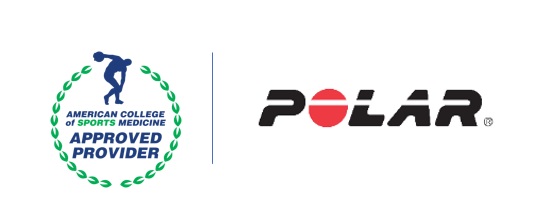Brett Lato, M.A. and POLAR |
Feb.
12, 2020

POLAR and ACSM recently hosted an industry-presented webinar with Brett Lato, M.A., entitled Essential Elements of Heart Rate Based Training – Key concepts & practical applications for training.

Several questions were asked by attendees during the webinar and the answers pertaining to HR zones, optimal equations, caloric expenditure and more are below.
Q: How to approach HR zones for populations that have chronic conditions (e.g., COPD, cardiac, cancer)?
It depends on the condition and the individual. For individuals with specific conditions, it is always best to consult and follow instructions provided by health care professionals. Using RPE along with HR can be an effective training strategy in many populations.
Q: I am a personal trainer and personally use Polar® products. I would like for my clients to use Polar heart rate technology with workouts. Is wholesale pricing available for Personal Trainers?
We do offer wholesale pricing for businesses. If you own the business and operate in the United States, you can apply for a wholesale account with Polar USA. If you are planning to use this with personal training clients, I strongly suggest checking out or free application “Polar Coach.” You can register to use this at no cost at Flow.Polar.com/Coach. It is a great tool for tracking client progress as well as adjusting and prescribing training.
Q: How does Polar calculate caloric expenditure?
Our energy expenditure calculation is based on your measured heart rate, activity through wrist movement, and your personal information: weight, height, age, gender, resting heart rate, maximum heart rate, and your individual maximal oxygen uptake (V̇O2max). The more personal metrics you add to your personal profile the more accurate the calculation.
Q: Does the Polar App only work with the Polar chest strap?
Polar has several apps for smart devices and tablets including Polar Beat (personal use), Polar Club (group exercise), Polar GoFit (physical education), Polar Team & Team Pro (Sports). Our chest straps (H9 and H10) do work with these applications. Additionally, Polar devices such as the OH1 arm band and our wrist-based devices, like Ignite, Vantage, and A370, work with the applications as well.
Q: I thought the Max HR formula changed in 2001 (208 - (.70 * age). They average out either formula (Karvonen). What do you recommend?
There are several calculations that can be used to estimate maximum heart rate, including the one you mentioned and others like the Fox, Tanaka, and Gulati. No matter which formula you select, it is important to note that all the formulas are based on population statistics and are intended to be no more than an estimation. Even the best estimation is still an estimation. Actual maximum heart rate for individuals can vary significantly from the estimations that the formulas provide. The only way to really know your own maximum heart rate is to have it measured on a maximal test.
I recommend using an estimation formula for an initial guide and then testing for MHR when possible. If testing is not practical, using the Rating of Perceived Exertion (RPE) chart in combination with heart rate live training data to help identify and adjust errors from estimations.
Q: Can our clients rely on HR monitors on cardio equipment in the gym for accurate readings if they are not wearing a device? Treadmills, elliptical, or bike hand HR readings?
In many cases yes, but this ultimately depends on the individual’s preference for accurate and reliable data.
Pulse sensors, like the ones commonly found on fitness equipment detect your pulse through contact with your hands. They pick up small electrical signals passing through your skin and use that information to provide an estimate of exercise heart rate in beats per minute (BPM). These devices are usually accurate, but for members seeking a higher degree of reliability I suggest using either a wrist-worn optical device or the standard chest strap which takes the electrical signal directly from the SA Node.
Q: Can individuals go over their maximum heart rate? What does it mean if they do?
Physically individuals cannot go over their actual maximum heart rate. Maximum heart rate is just that— it is the maximum. It cannot be exceeded. However, individuals can go over their estimated maximum heart rate. When this occurs, it simply means that the equation intended to predict Max Heart Rate did not work for them. If the maximum is exceeded, the estimation needs to be adjusted. Note: Movement artifact and arrhythmia could cause HR to exceed maximum estimation or measurement. Movement artifact can be minimized by ensuring proper fit, and anyone with a suspected arrhythmia should consult a physician.
Q: How do you fix an estimated Max HR that inaccurately says it’s above 100%?
Maximum Heart Rate (MHR) errors due to estimation can result in training heart rates that exceed 100%. This can be adjusted by conducting submaximal tests or by updating the original estimate using session-based maximums for reference. In this case, maximum heart rate would need to be increased. Errant HR readings exceeding 100% could also be caused by movement artifact. Errant readings can be minimized by ensuring proper use and fit of the sensor.
Q: How does optical HR work?
Optical Heart Rate monitoring (OHR) is a technology that is based on detecting your blood flow optically through the skin. LEDs on the monitor shine bright lights through the skin, and a built-in photodiode (sensor) detects the intensity of the light reflecting back from the skin. When your heart beats, it pumps blood through your vessels. When blood flow is stronger, less light is reflected back to the photodiode, and between beats when blood flow is weaker, more light is reflected back to the photodiode. From these variations in the intensity of the light reflecting back from your skin, the optical heart rate measurement can determine your heart rate.
Q: Have any of the Polar products been third-party tested for validity and reliability specifically for their Energy Expenditure predictions? Are there any published studies?
The Polar Research Index (Polar.com) is home to a database which includes third-party research.
Q: Does wearing the product around the clock increase the accuracy of recovery recommendations? If so, what is the ideal wear time?
Yes, it does. For ideal results a user would wear the device 24/7.
Q: Is it better to train at a percentage of HR max or the Karvonen method?
In my experience, this question is a matter of preference. Similar results can be achieved using either method. If you have researched and are more knowledgeable with one method of training over the other, I would suggest using the one where you are the most knowledgeable. The Karvonen formula factors in HR Reserve which could be argued is better because it considers the athlete’s current training status (fit, unfit, over trained, etc.). However, I am unsure if there is any research that proves it’s a more effective training strategy as opposed to equally effective.
Presenter:

Brett Lato, M.A.
Brett Lato currently serves as Manager of Training & Education with Polar Electro Inc. and has worked with heart rate technology for over 10 years. In his role, he works directly with personal trainers, physical educators, fitness directors, health club owners, strength and condition staff and various collegiate and professional coaches across the country. Lato works with a team of skilled trainers at Polar who conduct hundreds of on-line and on-site trainings annually, educating professionals on how best to utilize and incorporate heart rate based training into their unique programs.
Viewpoints presented in this blog reflect opinions of the author and POLAR and do not necessarily reflect positions or policies of ACSM.
Read More from POLAR

CEC Feature: Heart Rate Monitoring Assessment Course